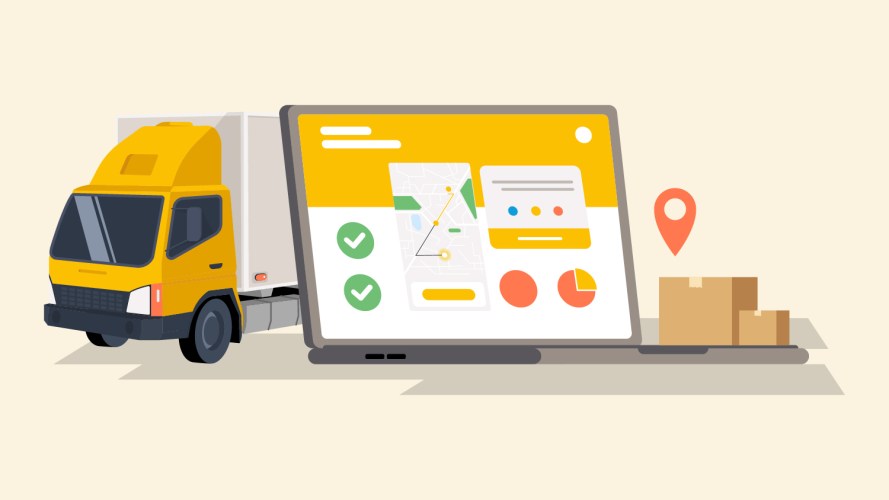3 Ways Generative AI Will Help Marketers Connect With Customers
3 min read


From a customer’s perspective, few moments in the shopping journey top the excitement of receiving an order. It all starts right after you click the Buy Button: You track your items with anticipation and follow along with every shipping update until a last-mile delivery driver drops it off at your doorstep. (Insert happy dance here.)
Order management is what makes this entire process possible — from order confirmation to shipping to much-anticipated fulfillment. It involves all the steps necessary to get items safely from a company’s warehouse into the hands of customers.
Order management can make or break a brand’s relationship with shoppers. The right strategies and systems can help you build customer loyalty, increase efficiency, and improve revenue streams. Here’s everything you need to know about how it works.
Learn how to fulfill and deliver — on your customers’ terms.



Order management is everything that happens after checkout. And an order management system is what controls all the downstream operational processes, people, systems, and partnerships that help fulfill orders. It’s a platform for managing orders, customer records, fulfillment, inventory visibility, payments and invoicing, and customer care.
Customers expect a lot when it comes to the post-purchase experience. Free shipping, simple and/or free returns, and sustainable business practices are all factors that make shoppers more likely to buy from a brand. They also want complete transparency about the status of their order, including its current location, its expected arrival time, and details about any problems in transit. The right order management system makes it easy to meet these expectations.
The customer experience doesn’t end at payment. The speed, transparency, and simplicity of fulfillment are key to customer satisfaction and loyalty. Get the post-purchase experience right and customers will reward you by placing more orders — but a sub-par experience can result in customer churn. In fact, 84% of consumers say they would stop buying items from a retailer after just one poor delivery experience.
Here’s where to focus your efforts — and make a few cost-effective tweaks — to provide a stellar order management experience that drives loyalty and brand love.
Customers demand flexibility in shipping and delivery – from one-hour and weekend delivery to in-store pickup. Be upfront about your ability to meet these expectations. Display the options you provide on each product page clearly so customers know what you offer before they check out.
Don’t disappoint and frustrate your customers with an out-of-stock notification after they’ve added an item to their cart. For business buyers, time is money, and any minute spent shopping for unavailable merchandise is wasted. If a product is out of stock or running low, indicate this on the product page so customers are aware. Inventory management capabilities built into your order management system can help automate this process and avoid hiccups.
Customers are naturally curious about their orders, so give them the ability to check order status and receive updates via text or email. To avoid snafus, make it easy to edit shipping details after customers have placed an order. Returns, too, should be self-serve, allowing customers to easily print return labels and choose how and where to return items. Self-service gives shoppers more control over their experience and helps you lower costs associated with service and support.
Service agents and sales reps are on the front lines of the customer experience. They need to help customers with their orders and make the entire interaction feel seamless. This requires the right tools to reduce call handling time, increase efficiency, and give reps complete visibility into orders. Technology should help them place orders on behalf of customers and make shipping and delivery changes to existing orders, when necessary. This is a proven growth strategy: Thirty-eight percent of digital leaders say customer service drives a substantial amount of incremental revenue.
Manual processes for managing inventory, order routing, status monitoring, and returns management quickly become unpractical. The good news? The best order management systems come with AI tools that automate these tasks. In fact, one third of organizations have completely automated the tasks of order status monitoring and reporting.
Order management systems used to be relegated to the back office, typically within the logistics division of a company. But that doesn’t work in a customer-centric economy where order management is so central to the overall customer experience.
All the work that brands put in throughout the customer relationship management (CRM) lifecycle — awareness, marketing, site experience, consideration, acquisition, conversion, and more — leads to this one moment. If companies fail to deliver on their end of the value exchange (money for goods and services rendered), does anything else that came before really matter? Order management systems must deliver on that brand promise.
After a customer clicks the Buy button, an intricate dance begins to carry out the order. Storefronts may interact with as many as 39 different systems to complete this part of the customer journey. The most common types of systems are tax, payment, fraud, inventory management, accounting, enterprise resource planning (ERP), and shipping. Here’s what should happen during an effective order management process:
When it comes to inventory management, a clear view helps you optimize storage space, forecast demand effectively, and save money. You’ll be able to avoid costly mistakes like out-of-stocks, overstocks, mis-picks, and mis-shipments. This also increases the chances you can keep shelves stocked at the right capacity and deliver goods quickly and correctly.
Can customers expect standard shipping, or will their order be routed to a warehouse for customization? For special orders, a team may need instructions to build a personalized product by hand. The right order management system will help you take all of this into account and efficiently manage the flow of goods across your entire supply chain.
This final step of the order management process is known as last-mile delivery. With a flexible, integrated order management system, your last-mile fulfillment is quick, reliable, and transparent. You can even use this step to trigger new marketing efforts. For example, when a customer receives the new sofa they ordered, you can send them a personalized email suggesting matching end tables or chairs.
Creating a stellar post-purchase experience is no easy feat, especially as customer expectations around shipping times and costs continue to skyrocket. Here are a few key challenges businesses face when it comes to order management — and the solutions you need to meet the moment.
Omnichannel shopping: Most customers (71%) prefer shopping across multiple channels, and it’s critical to sell where your customers are engaged, from social media to retail apps to your ecommerce site. But with every additional channel comes more complexity for order management. For example, you’ll need a way to quickly prioritize inventory for your most profitable channels when stock is running low. To do this, you’ll need a system that integrates with each channel seamlessly, enabling you to offer a truly omnichannel experience.
Scalability and expansion: Expanding globally is a great way to grow your business: Foreign sales drive an estimated 39% of revenue, on average, at companies that sell internationally. But it requires post-purchase optimization.
If your business is growing and you plan on selling — and shipping — to new locations abroad, you’ll be faced with some unique challenges. In fact, commerce leaders list customs and shipping as top factors that hinder their international efforts. Consider the complexity of international supply chains, diverse regulations, and the myriad partners and manufacturers involved. The right inventory and order management systems will offer capabilities to help orchestrate it all, making it easier to navigate these nuances as you enter new markets.
Shipping costs: Most customers want delivery to be free. In fact, free shipping is a top factor that makes customers more likely to buy from a brand. What does that mean for your business? It’s crucial to do everything you can to keep shipping costs low — for you and your customers.
To do this, the right strategies, partnerships, and technology are paramount. For starters, focus on optimizing your packaging (think: lightweight, low-cost, and sustainable), and offer in-store pickup to reduce last-mile shipping expenses. Simplify processes for your fulfillment team and ensure efficient order routing. Automation and AI can help here. The right AI-powered shipping tools can analyze customer addresses and their preferred shipping windows to determine which carrier and delivery service is best for each scenario, which route is fastest, and how to deliver sustainably. This will save you both time and money, all while reducing possible shipping errors.

3 min read

6 min read
The right order management system will help you reduce costs, deliver efficiently, and provide stellar post-purchase experiences. Here’s what to keep in mind when it comes make-or-break to key features:
Integration with other systems: Your order management system shouldn’t be an island. It should be connected with other systems and areas of your business, like your CRM, customer service, commerce, and sales platforms. This makes it easier for your teams to get easier access to better insights about orders, routes, inventory, and your supply chain. It also makes it easier to automate tedious tasks, increase efficiency, and provide better post-purchase experiences to your customers.
Inventory management and visibility: Real-time inventory visibility enables bulk purchasing while cutting storage costs. This also makes it possible to more accurately predict demand and make timely purchases so you can avoid costly mistakes like out-of-stocks, overstocks, mis-picks, and mis-shipments. When inventory management and visibility are part of your order management system, it’s easier to build customer satisfaction and drive repeat business.
Real-time insights: Yesterday’s data won’t help you solve today’s problems. With access to real-time data, you know exactly what’s going on with your order management processes so you can resolve issues quickly and keep operations smooth. For example, real-time insights will alert you when products from manufacturers aren’t making it to your warehouses on proper timelines, so you can better manage your supply chain. In-the-moment data helps you eliminate inefficiencies, reduce costs, and deliver stellar customer experiences.
Automation and AI: Artificial intelligence makes it possible to update inventory counts, issue reorders, and service orders automatically. Ultimately, that means lower costs, increased efficiency, and happier customers. Considering that growing revenue and improving productivity are at the top of businesses’ priority lists, automation is a key tactic for success. About one-third of companies have fully automated returns management, inventory management, order routing, and order monitoring.
Order support: Your order management system should enhance your customers’ experience with fast and easy support tools like cancel, return, and reshipments. It should also give sales and service agents contextual data like order history, customer records, payment terms, and service tools — all on one screen. These are the kinds of order servicing capabilities that will increase revenue and customer satisfaction.
Order management isn’t just about processing orders. It integrates customer-facing systems that affect the post-purchase experience including ERP, CRM, sales, service, and commerce. Order management systems make everything available and accessible to all stakeholders in a unified platform.
With a flexible, integrated order management system built to support omni-channel journeys at a global scale, you’ll have all the tools you need to become more successful and keep customers coming back for more. Customers expect a smooth post-purchase experience, and these strategies will help you deliver.
See how customer-first, distributed order management works.




Get the latest articles in your inbox.


